FuturePlay Exclusive: Zephatali Provides Insider Perspectives on Airspeeder Racing
Dive into the thrilling world of Airspeeder racing with champion pilot Zephatali Walsh! Discover his journey from drone surfing to piloting these high-tech flying cars, the future of racing and transportation.
In the heart of the Airspeeder headquarters, Lexie Janson interviews Zephatali Walsh, a three-time flying car racing champion and seasoned Airspeeder pilot. Interestingly, Zeph’s journey into the world of Airspeeder racing had unconventional beginnings – he was once a surfer, riding the waves of adrenaline in a different realm. Let’s hear from Zeph and Lexie as they talk about all the new updates with flying cars.
How did he get started?
Zeph’s initiation came through the captivating world of First Person View (FPV) drone racing. Intrigued by videos showcasing daring drone flights, his curiosity intensified after stumbling upon an interview with an Australian racing pilot who mentioned he gained notoriety in the space by using a simulator. Zeph swiftly gained recognition by honing his skills in a simulator, seamlessly bridging the virtual and real worlds.
During his first week of playing the simulator, fate brought him face-to-face, or screen-to-screen with Min Chan Kim (MCK), a prominent drone racer, in a gaming server. This encounter catapulted Zeph into the Drone Champions League (DCL), where he not only participated but also earned a spot on their draft team.
Because of Australia’s heavy regulations and small incentives to continue drone racing, Zeph looked outward to find new income streams. As he was surfing the web he came across an Airspeeder video and liked it even more, especially since they were located in his hometown.
How is flying car racing progressing?
Zeph starts off by mentioning how it is a tough endeavor and that the technology, regulations, and sporting aspects have made the road more difficult and slowed down the process more than they would like.
One of the good things about Airspeeder is what they want to build. While most companies are focusing on flying taxis and replacing helicopters, eventually we want to have these crafts used for personal transportation. More developments can happen when the vehicle is designed for racing, making it better for consumer use.
While they couldn’t go into the details, another problem with the tech is the augmented reality aspect that allows racers to see a virtual track on their screens. Zeph acknowledges the intricacies but sees them as stepping stones towards perfecting the racing experience for both enthusiasts and future commuters.
What do you think is the future of sport?
We have a lot of sports where the machine meets the athlete, such as drone racing, flying car racing, jetpack racing, and more. Zeph believes the main problem humans face is that we have a limit on what we can do, whereas machines have more capabilities both physically and learning wise.
Zeph also raises an interesting question, since taking drugs for athletes is cheating, will adding technology to humans also be considered cheating? Would someone with Elon Musk’s Neuralink chip be considered cheating since they are enhancing their body, or going past their limitations?
Maybe one day we’ll be able to control our flying cars with our minds, and Zeph believes we aren’t too far from this becoming a reality.
He mentions that he was studying psychological science at university, and acknowledges that we are on a path of innovation, wanting to create more. This strive for more allows us to go into subjects like quantum computing, and make it possible for tools like ChatGPT and Gemini to be built and constantly updated, or adapt.
What type of Machina Sports are you watching?
Zeph tells us that his personal picks are drone racing, flying car racing, and robot wars. His main Instagram feed consists of drone racing, flying cars, and photography, which reflects his passion for the intersection of technology and sports. You could even argue that photography and cinematics have some elements of Machina Sports, combining humans with machines.
What is the future of Airspeeder?
Crewed flights. The ambition is clear – real pilots in real crafts racing through the skies and not just using a simulation to race. Sooner rather than later, they want all eVTOLs to be racing each other in the air using their teams in the craft itself. While the process seems slow, they are doing it as fast as they can. The team is putting a great risk with their crafts even just flying them with a remote because of all the resources, time, and technology that goes into each one.
While drone racing is much more popular, the team at Airspeeder wants flying car racing to be the same with its mainstream adoption. Where it will be as common as drone racing in everyday conversations. The tech of these drones is impeccable and capable of going 0-200 kmph in less than 2 seconds. However, the major drawback to the sport is that the drones are very small making it somewhat difficult to view.
Zeph also goes on to give props to Elon and everyone at Tesla and SpaceX, and how they are bringing more mainstream adoption of technology with humans. And that the performance is what makes people buy, not marketing anything of the sort.
The same is true with what they are doing at Airspeeder. Showcasing the technology of flying cars, and letting the people become excited themselves instead of making large strides for marketing.
Drone
The Future of Racing: Beyond Wheels and Into the Skies

How flying cars and jet suit racing are redefining the boundaries of sports.
In a world obsessed with speed, the race track has long been a battleground for the most audacious of dreamers.
It’s where innovation meets adrenaline, where the sound of engines and the screech of tires on asphalt have defined generations of speed fans.
But as we stand on the brink of a new era, the race track is no longer confined to the limitations of the ground. We are entering an age where the sky becomes the ultimate racing frontier, and the boundaries of sports are being redefined right before our eyes.
Believe it or not — we already have a virtual reality gates for the flying cars.
Growing up, I was mesmerised by speed. The faster, the better. Cars, bikes, rollerblades — if it could move, I wanted to see how fast it could go. Yet, even in my wildest dreams, flying cars were a fantasy reserved for superheroes and sci-fi movies.
Little did I know, the future of racing was quietly brewing, not in the pages of comic books, but within the labs and minds of engineers and visionaries around the world.
And I was a part of it. — Lexie Janson, a flying car racing pilot
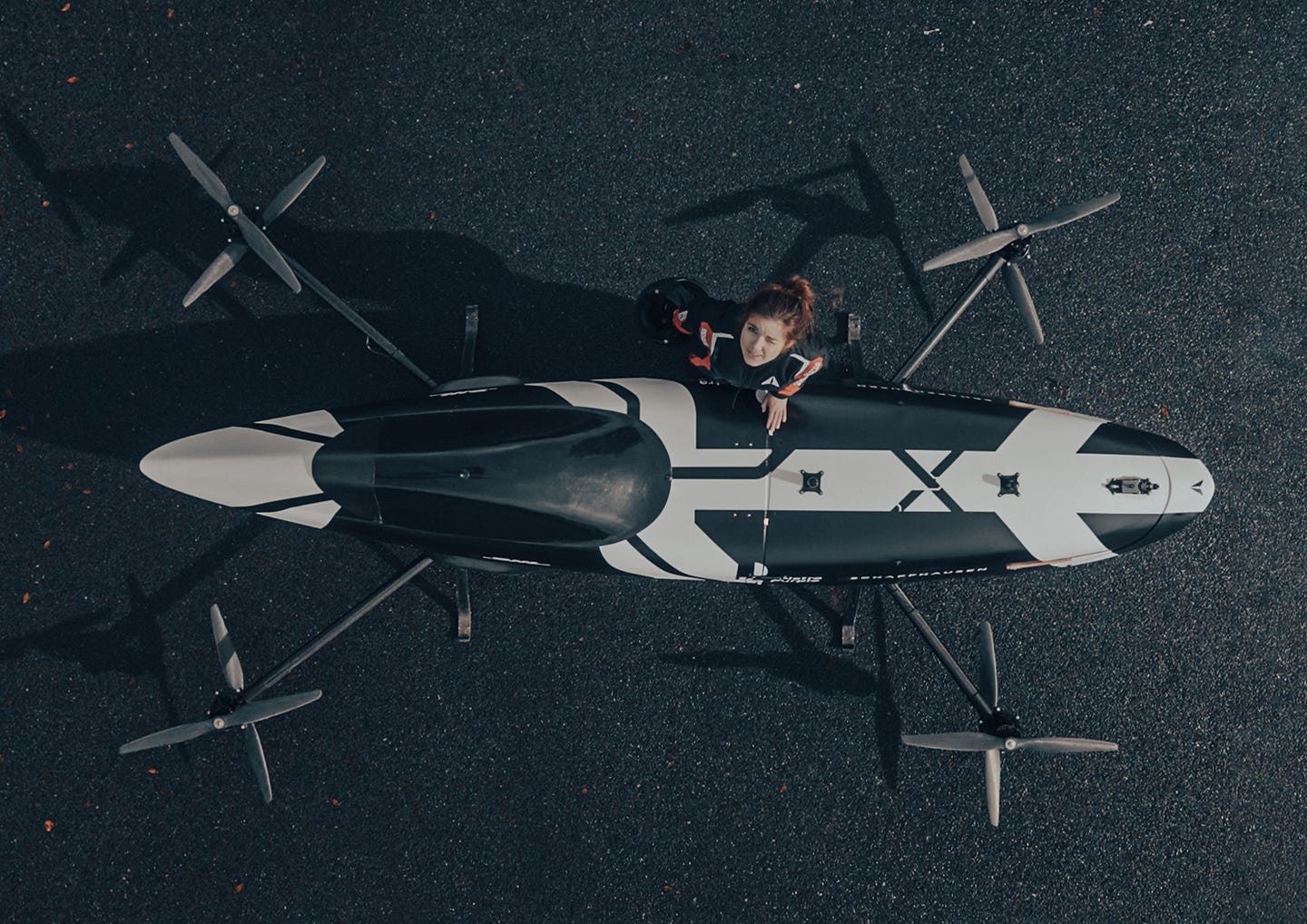
When Dreams Take Flight
The pursuit of flying cars has long captured the human imagination. It’s a symbol of our desire to break free, to defy the very laws of nature that have bound us. But what once seemed like a distant dream is now palpably close.
Companies around the globe are developing flying cars, not just as luxurious gimmicks, but as the next big thing in personal transport and, more importantly, in racing.
Imagine cities hosting grand prix events not on closed circuits, but above them, with flying cars racing between skyscrapers, iconic landmarks, and down the riverbeds.
And of course — crashing, which is a way less desirable part of it.
Maybe let’s skip landmarks and historically important spots.
The skillset for pilots in this new era goes beyond steering and braking. It is a mix of jet fighter pilot and Formula 1 driver. It’s about surviving the G-forces, creating a strategy for 3D circumstances and quick reaction times (especially if another pilot comes from above or below).
Jet suit racing (Iron Man!?)
If flying cars promise to redefine racing on a macro scale, jet suit racing touches upon the individual’s quest for speed (and nerdy dreams of becoming an Iron Man)
Picture this: racers dressed in jet suits, lifting off from the ground, powered by the sheer force of technology strapped to their backs and hands. This sport requires an extreme core balance and body control strength. One missed move may mean crashing or spinning uncontrollably.
“Oh, this is still an imagination,” you may say. But it’s not. It’s real:
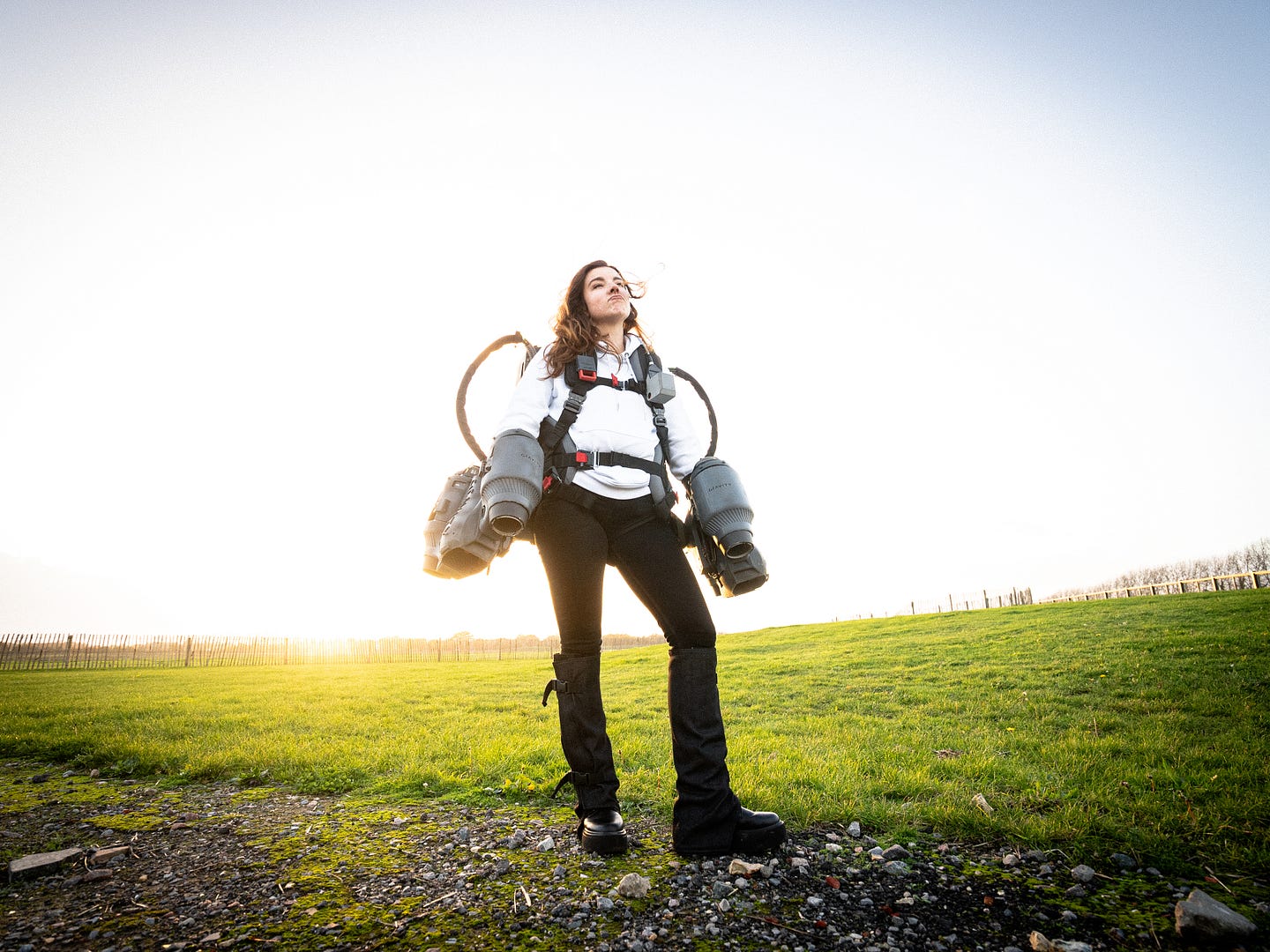
In February 2024, Dubai, UAE — Gravity.co has conducted the first jetsuit race in the world. In this historical event 8 pilots have been fighting for the title of the first champion. The event had it all: crash into the water, disqualification, a pilot “losing it” and extreme circumstances.
The final race lasted 90 seconds.
Its winner — Issa Kalfon has left his name on the pages of history for ever. An ex-gymnast claims that his past career path was one of the deciding factors in his training and win. Because machina sports are not just about the machines. It’s about human and the machine.
Jet suit racing isn’t just about who crosses the finish line first; it’s a testament to human ambition and ingenuity. Each race pushes the boundaries of what’s possible, challenging pilots to outmanoeuvre their opponents while maintaining control over their high-powered suits.
It’s exciting, nerve-wracking and extreme.
But Gravity.co is not only about racing. Their jetsuit is also created to help medics get to their patients in less favourable spots, transportation and military use.

FPV Drone Racing — Esports and athletes
But not all the new sports require athletes to get into any type of a suit. FPV Drone racing is a discipline that connects esports with athletic abilities.
As esports players get their time in the gym for reaction times, cardio, and general health — FPV Pilots need to do the same to withstand the stress and pressure during their races.
It’s not all about the drones that one can buy in the store. It’s mostly self-built racing drones that can fly with a speed of 200km/h.
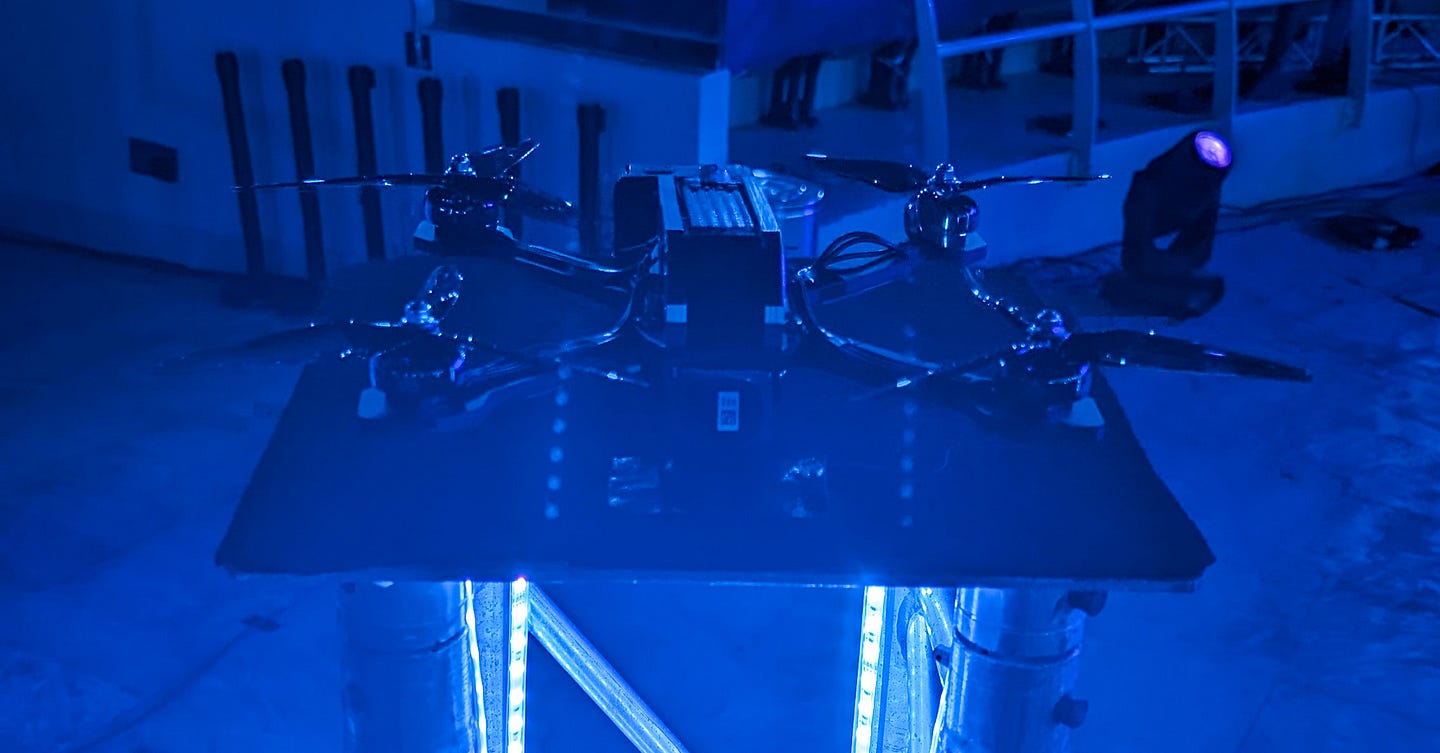
During an FPV Race 4–8 pilots fly the FPV Drones through an obstacle track. Pilots see what their drones see in real time through FPV Goggles, and control them via an RC controller.
Pilots often experience midair collisions, crashes, and exciting chases throughgout the race. But is it a spectator sport? Yes! In the recent event MultiGP Sharjah — FPV Drone Racing has reached a brand new level of spectator-friendly event. The audience could see what the pilots saw on the screens, but also “line of sight”. And the view? Easy to understand, and pretty exciting. If you are interested in more visuals — check out our vlog.
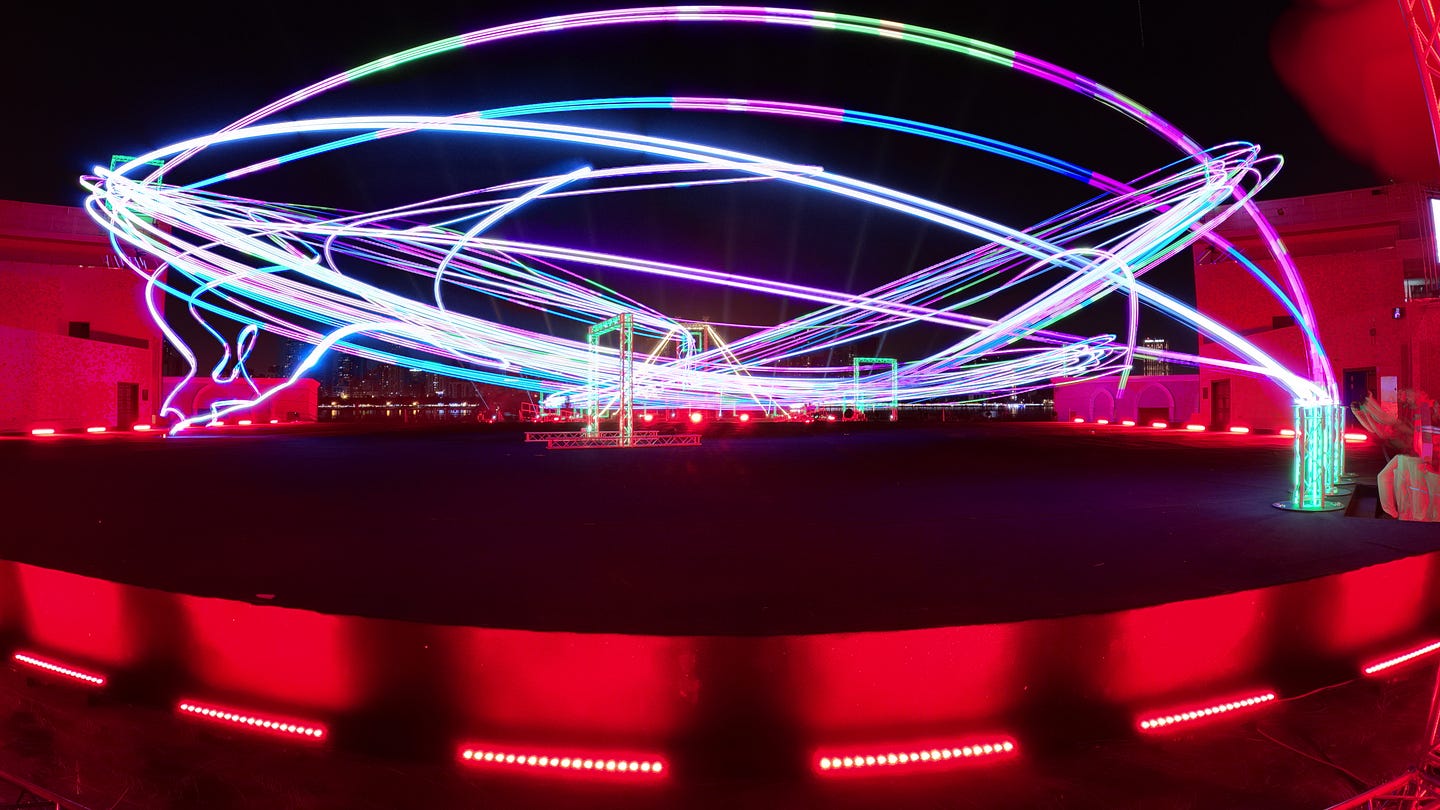
The Evolution of the Spectator
The sports as we know them haven’t changed much in the last decades, as the human bodies have limited capabilities. This is why machina sports are popping here and there showing that human and the machine mean even more excitement and a new, fresh outlook on sports and athletes.
As racing seems to take to the skies, so too must our conception of spectatorship evolve. Traditional racetracks may transform into multi-dimensional arenas, offering views from below, above, and all around.
Can you imagine!?
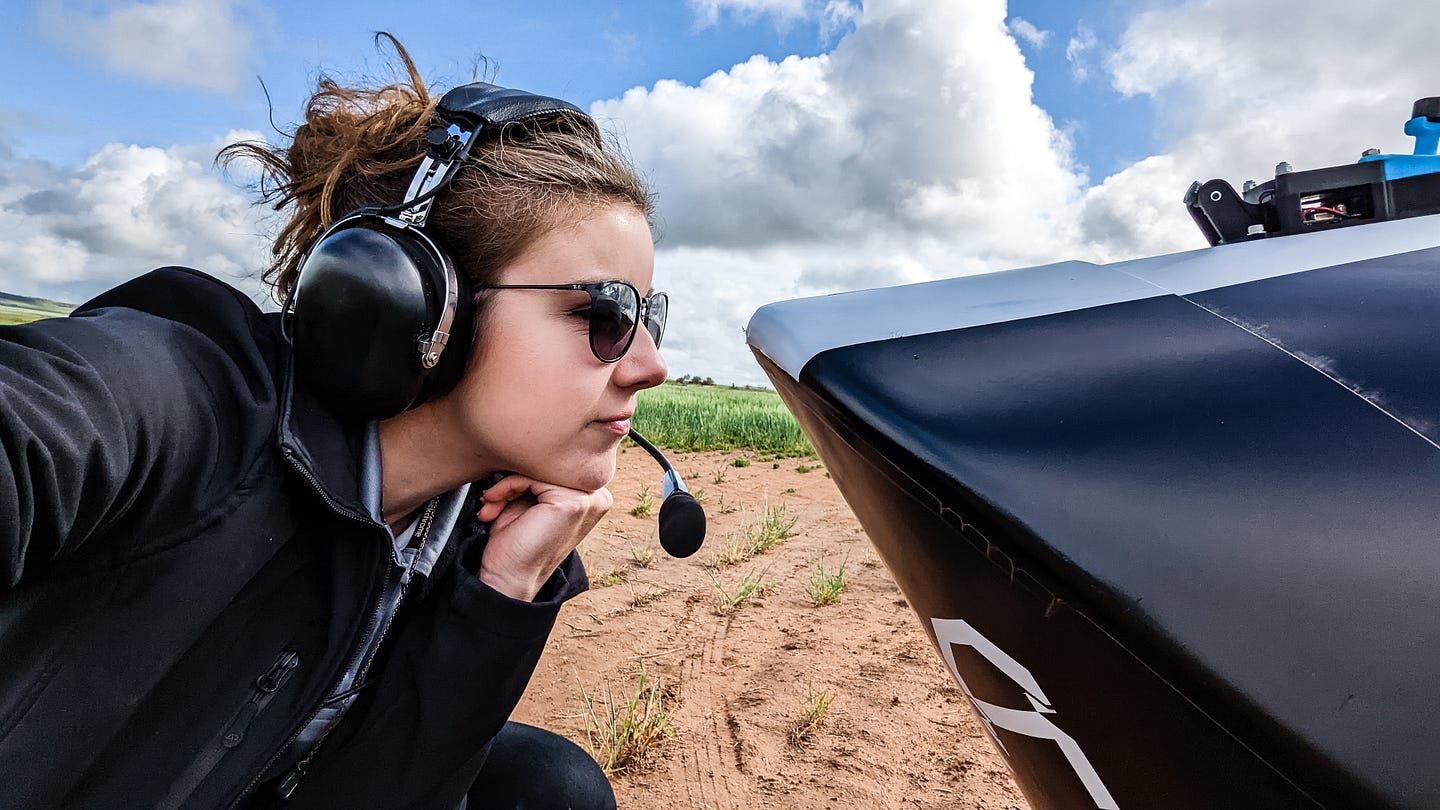
Fans might follow races through augmented reality interfaces, experiencing the flight from the perspective of their favourite pilots. With the virtual reality tracks — the world becomes a stage, turning spectators into an integral part of the racing narrative.
And I guess we are all here for it.
Embracing the Future
The migration of racing from wheels to the skies is more than an evolution in sports; it’s reimagining of human potential.
Picture cyborgs…
In this era of air racing, every pilot’s journey, every race, every breathtaking moment reminds us of our collective drive to break barriers and explore new horizons.
As a child, I could only dream of such marvels. Yet, as we stand on the cliff of this thrilling future, it’s clear that those dreams weren’t just flights of fancy (pun intended).
They were visions of what was to come.
The future of racing is here, and it’s inviting us to look upwards, to the skies where the next chapter of human achievement is waiting to unfold (and entertain).
Drone
How Women’s representation in FPV shapes the scene

KalliFPV’s Journey in the Drone Racing World

But is it?
It was representation and passion that got KalliFPV into FPV Drone Racing, a\nd her ascent in the drone racing world is more than just a personal triumph; it’s a beacon for diversity and inclusion in a space where both are urgently needed.
A Sky Without Limits
Kalli’s journey isn’t just a story of overcoming odds; it’s a narrative that mirrors the ongoing evolution in STEM — a field continuously enriched by the diverse perspectives women bring. Her path from curiosity to competitive racing sums up a broader truth: when given the opportunity, women not only participate but excel and innovate.
Her inspiration? A blend of familial bonds and a natural inclination towards the mechanics of flight. Initially drawn to the sport by her father’s own passion, Kalli quickly transitioned from an observer to a key player.
“Back in 2022…I was like, dad, I really want to get into flying,”
Kalli recounted, reflecting on the moment her journey took flight in a FuturePlay Interview. It’s a testament to the power of mentorship and representation. Seeing someone you identify with succeeding can sometimes be all the push you need to get on a similar path.
The Simulator as a Springboard
Kalli’s rigorous dedication to mastering her craft through simulators — a digital proving ground where countless hours are spent refining skills — highlights an essential message about the importance of accessible resources in fostering talent.
“Most of my practicing I did on simulators. I practiced at least five hours a week,” she shared.
This statement not only showcases her dedication but also underlines the role of technology in democratising fields like drone racing, making them more accessible to diverse groups.
Breaking Barriers and Building Community
Kalli’s decision to join the all-girls team Mach1 is a vibrant illustration of the changing landscape of drone racing — a world becoming increasingly inclusive.
“Of course, an all-girls team, of course, I’ll join it,”
She enthusiastically remarked, underlining the significance of finding a community where she felt represented and supported. Here, Kalli’s narrative intertwines with the larger discourse on the importance of community in breaking down barriers and fostering a sense of belonging.
A New Horizon
KalliFPV is more than a competitor; she’s a symbol of change in the aerial arenas of drone racing and beyond. Her story is a powerful reminder that with passion, mentorship, and access to the right resources, the sky is not the limit but the beginning.
In sharing KalliFPV’s journey, we not only celebrate her achievements but also ignite a conversation about the future of women in STEM and sports. It’s a discussion about the potential that lies in empowering young women to explore, to create, and to dream without limits.
As KalliFPV continues to fly, her content serves as an inspiration — to young girls who look up at the sky and see not a limit, but a vast expanse of possibilities. It’s a call to the community, to mentors, and to organisations to invest in these dreams, to nurture these ambitions, and to watch as they take flight, transforming our world in the process.
What are your thoughts about the representation in sports and scientific fields?
If you want to watch the entire interview with Kalli – be sure to follow us on YouTube
Editor's Picks
FuturePlay Exclusive: Bruno Senna’s Journey into Flying Car Racing and the Future of Machina Sports
Dive into the world of flying car racing with Bruno Senna! Explore the challenges, thrills, and potential of Machina Sports, the future of competitive sports.

In an exclusive interview with Lexie Janson, Bruno Senna, shares his insights on flying car racing and the potential future landscape of Machina Sports. As we delve into this exhilarating conversation, we uncover the intricacies of Bruno’s involvement, his thoughts on flying cars, and how it compares to his previous profession as a Formula 1 driver, training regimens, and valuable advice for aspiring enthusiasts.
Bruno’s Intro to Flying Car Racing
Nephew of F1 legend Ayrton Senna, Bruno carved his own path in motorsports, competing in Formula One. However, the track wasn’t his final destination. Driven by a lifelong passion for speed and innovation, Bruno embraced a new challenge: Flying Car Racing. Reflecting on the start of his journey, Bruno shares he’s always been into cars, computers, and drones, and the marriage of these interests in the form of a flying car was too enticing to ignore.
Bruno’s leap into flying car racing took a surprising detour via FPV drones. A Star Wars aficionado, he was captivated by a video of French pilots maneuvering drones through a forest, reminiscent of his beloved sci-fi saga. This sparked a parallel passion for FPV flying, which unexpectedly rekindled his racing ambitions, propelling him towards the cutting-edge world of flying car racing.
Today, Bruno’s enthusiasm for Machina Sports extends far beyond the realm of flying cars. He is currently in the process of building quadcopters, he loves the feeling of getting his hands dirty and creating these amazing flying machines.
Transitioning from FPV to Flying Car Racing
Delving into the intricacies of flying car racing, Bruno sheds light on the unique challenges posed by the Airspeeder. Unlike traditional FPV drones, flying an Airspeeder involves a significant learning curve. Bruno notes it’s like flying a big airplane in that you need to plan ahead. The transition from smaller drones to the Airspeeder requires a recalibration of skills, underscoring the distinctive nature of piloting a larger, more complex aircraft.
Despite the initial challenges associated with the FPV feed of the speeder, Bruno expresses his enjoyment of the experience. “It’s a work in progress,” he remarks, highlighting the immersive nature of flying the machine and the satisfaction derived from mastering its nuances. The limited battery life, an inherent aspect of the developmental process, poses a unique challenge that racers must navigate in the pursuit of refining the technology.
Intriguingly, Bruno finds the incorporation of VR gates in the racing experience to be a fascinating aspect. These gates, designed for FPV drone racing, add an additional layer of complexity to the flying car race, encouraging racers to hone their skills not only in speed but also in precision. Bruno envisions broader applications for VR gates, believing they could serve as a path for both driving and flying, expanding the scope of their utility beyond the racing track.
Formula 1 vs. Flying Cars

Comparing the dynamics of Formula 1 racing to the unique challenges posed by flying cars, Bruno offers his insights. In traditional car racing, the objective is clear – go faster than the competition. However, flying cars introduce a paradigm shift where conserving battery life and adopting a more conservative flying approach becomes more important than speed itself.
It’s a whole different mind game when you have another dimension to fly on.
Bruno SENNA
Drawing parallels to the racing strategies of the ’80s, where drivers had to strategically manage their brakes and fuel consumption. It is imperative to fly conservatively to maximize flight time. Bruno is excited about the future of flying cars and sees it as the beginning of a new era like Formula 1.
Training for Flying Car Racing
The preparation for flying car racing demands a multifaceted approach, encompassing physical fitness and acclimatization to the unique demands of flying. Bruno Senna approaches this challenge with the same dedication and precision that define his racing career.
Training at an F1 level forms a crucial component of Bruno’s regimen. However, flying cars introduce a novel dimension – the need to adapt to G forces while navigating the skies. To familiarize himself with these forces, Bruno took to the skies as a passenger in a jet trainer, immersing himself in an environment that mirrors the conditions he will encounter during flying car races
Future of Flying Car Racing
Looking ahead, Bruno Senna envisions a transformative future for flying cars. Within the next five years, he hopes to witness advanced aircraft navigating the skies as a viable mode of transportation. While acknowledging that he may not experience this revolution firsthand due to his age, he expresses optimism that younger generations will revel in the marvel of airborne commuting.
Lexie suggests that even if she cannot actively participate in flying car racing, she would be keen on training others or becoming a coach. Bruno finds this prospect intriguing, recognizing the value of experienced individuals contributing to the development and education within the field.
Future of Machina Sports
Exploring the potential trajectory of Machina Sports, Bruno emphasizes the transformative power of technology in shaping new sports. While acknowledging the inherent safety and technological limitations in air racing, he remains optimistic about its widespread appeal. The uniqueness of air racing, he believes, holds the key to capturing the imagination of sports enthusiasts globally.
Discussing the role of AR glasses in enhancing viewing experiences, Bruno envisions a new dimension of sports entertainment. He suggests that AR glasses, equipped with high-resolution capabilities, can revolutionize how audiences engage with flying car races. Viewers can put on these goggles and see exactly what the pilots are seeing.
Bruno also mentions that integrating the events on your phone can be a big step not only for machina sports, but other traditional sports as well. Events can have their own app which allow for live commentary while you’re at the event, the track and virtual gates can be present through your phone if you don’t have FPV goggles, and other implementations for viewers.
Machina Sports and the Catalyst for Technological Innovation
Bruno believes that the popularization of sports like drone racing and flying cars hinges on reaching a broader audience. He contends that the virality of one of these sports could serve as a catalyst for innovation within the industry. It just takes one of these sports to go viral, and suddenly, you have a wave of interest that propels innovation and advancements.
According to Bruno, the transformative potential of Machina Sports lies not only in its entertainment value but also in its capacity to inspire the next generation of technologists and engineers. By capturing the imagination of young minds, these sports create an entry point for engagement with science, technology, engineering, and mathematics (STEM) disciplines.
Tips for Aspiring Enthusiasts
Simulator training, particularly through gates, provides an engaging and practical way to familiarize oneself with the intricacies of flying. The integration of flying simulators and FPV simulators emerges as a crucial stepping stone, allowing enthusiasts to refine their skills in a controlled environment.
Bruno recommends exploring the world of drone racing as a segue into flying cars. The dynamics of drone racing share commonalities with flying cars, providing enthusiasts with a foundation to build upon. He points to the Celeros game as an engaging and educational tool, serving as an excellent entry point for individuals looking to immerse themselves in the field.
Personal Advice
Senna imparts wisdom drawn from his racing career, stressing the essential role of physical fitness for anyone, not just those interested in flying cars. The demanding conditions of flying cars highlight the need for peak physical conditioning to endure the strains of flight.
Elaborating on the mental aspect of flying cars, Bruno delves into the psychology of competition. Bruno states that 50% of racing and competition is being able to control your mind in stressful situations and essentially being comfortable in uncomfortable positions.
In essence, Bruno’s advice transcends the realm of flying cars, offering a holistic perspective on the importance of physical and mental resilience in navigating life’s challenges. The lessons learned from the high-stakes world of racing become valuable insights applicable to broader contexts.
Final Thoughts
Bruno Senna’s journey into flying car racing unfolds as more than just a personal exploration; it is a testament to the transformative power of technology, the allure of innovation, and the potential of sports to shape the future. As the skies become the canvas for a new era of racing, Bruno invites us all to witness the unfolding spectacle and embrace the boundless possibilities that Machina Sports holds for generations to come.



















